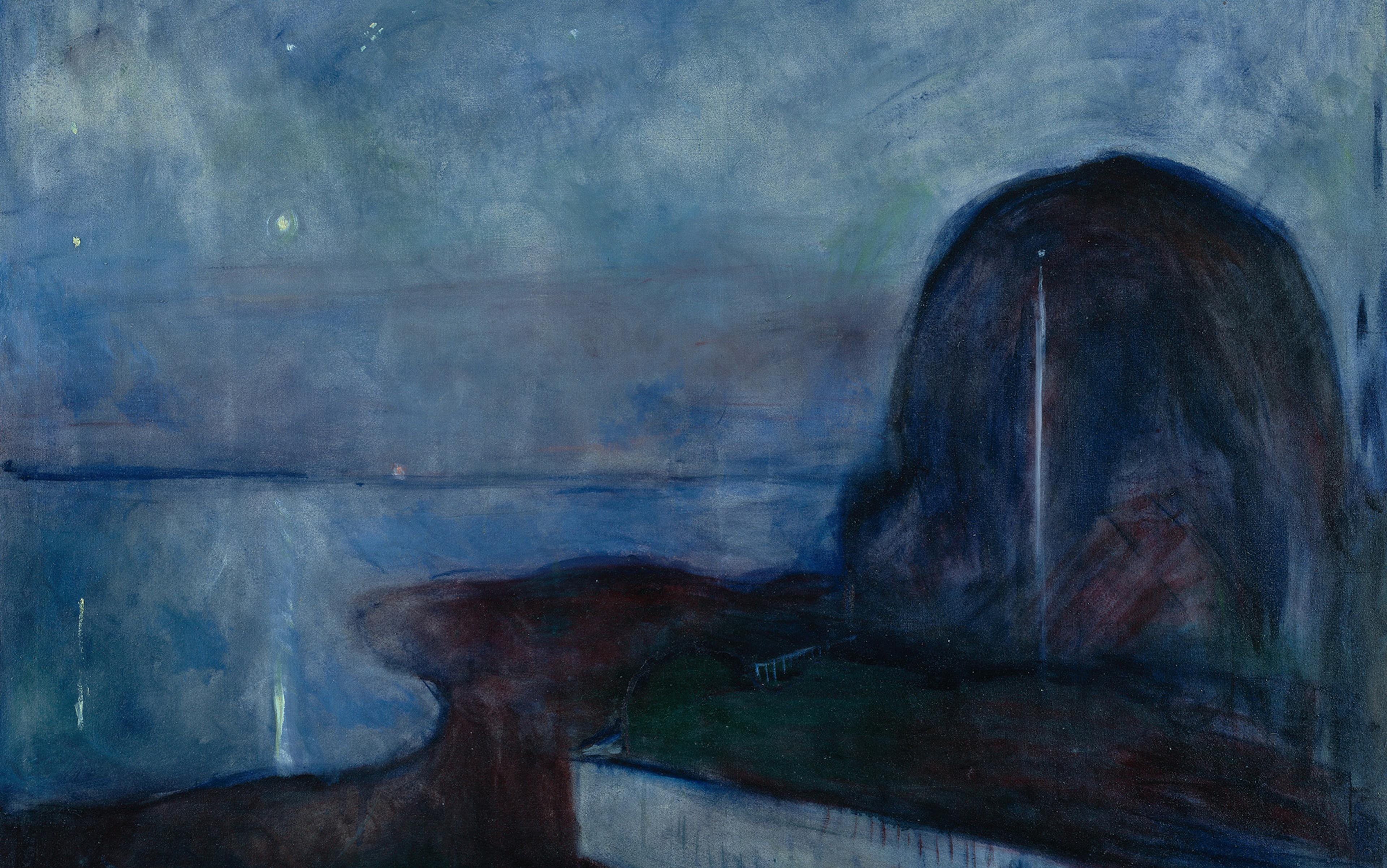‘From all things One and from One all things,’ wrote the Greek philosopher Heraclitus some 2,500 years ago. He was describing monism, the ancient idea that all is one – that, fundamentally, everything we see or experience is an aspect of one unified whole. Heraclitus wasn’t the first, nor the last, to advocate the idea. The ancient Egyptians believed in an all-encompassing but elusive unity symbolised by the goddess Isis, often portrayed with a veil and worshipped as ‘all that has been and is and shall be’ and the ‘mother and father of all things’.
This worldview also follows in straightforward fashion from the findings of quantum mechanics (QM), the uncanny physics of subatomic particles that departs from the classical physics of Isaac Newton and experience in the everyday world. QM, which holds that all matter and energy exist as interchangeable waves and particles, has delivered computers, smartphones, nuclear energy, laser scanners and arguably the best-confirmed theory in the entirety of science. We need the mathematics underlying QM to make sense of matter, space and time. Two processes of quantum physics lead directly to the notion of an interconnected universe and a monistic foundation to nature overall: ‘entanglement’, nature’s way of integrating parts into a whole, and the topic of the 2022 Nobel Prize in Physics; and ‘decoherence’, caused by the loss of quantum information, and the reason why we experience so little quantum weirdness in our daily lives.
Yet, despite the throughline in philosophy and physics, the majority of Western thinkers and scientists have long rejected the idea that reality is literally unified, or nature and the Universe a system of one. From judges in the Inquisition (1184-1834) to quantum physicists today, the thought that a single system underlies everything has been too odd to believe. In fact, though philosophers have been proposing monism for thousands of years, and QM is, after all, an experimental science, Western culture has regularly lashed out against the concept and punished those promoting the idea.
It wasn’t always that way. In ancient times, the concept of monism held more weight in the popular mind. Philosophers in the school of Pythagoras (c570-490 BCE), renowned for his alleged discovery of the geometrical relation among the three sides of a right triangle, identified the number one as the centre of the Universe. Heraclitus’ contemporary Parmenides (c520-460 BCE) believed in reality as a timeless ‘one, that is and that is not not to be’. And Plato, arguably the most influential philosopher ever, is said to have taught monism as a secret doctrine at his academy, to be disseminated only orally. Indeed, monism later evolved into a trademark of his school, and Neoplatonists such as Plotinus (c205-270 CE) wrote about ‘the one’ that is ‘all things’ and ‘being’s generator’. Around the same time, mystery cults popular in late antiquity advocated a hidden unity behind the many gods of the Greco-Roman polytheistic pantheon, and understood the different deities as representations of the various facets of a single, unified reality.
Later on, philosophical ideas derived from Plato’s monistic instincts competed with Christianity to become the dominant worldview of the Roman Empire. Christianity prevailed.
Even then, Christianity adopted Platonic ideas by identifying the monistic ‘One’ with God. But Christianity drew also on dualistic philosophies such as Manichaeism, which advocated a world caught in an epic struggle between good and evil. This is how concepts such as God and devil, heaven and hell, or angels and demons received their prominent role among Christian beliefs. At the same time, the monistic influences were pushed into an otherworldly beyond. The Christian God was understood as different from the natural world that he governs from outside.
A student who claimed that ‘God, the world, and nature, are but one thing’ was hanged for blasphemy
With the Christian Church rising to political power and the fall of the Roman Empire, much of antiquity’s culture and philosophy got lost, and monism got suppressed as a heresy. If ‘all is One’, God gets conflated with the world, and medieval theology understood that as atheism or a devaluation of God.
When in 855 John Scotus Eriugena, a medieval philosopher at the court of the Frankish emperor Charles the Bald, described God as an ‘indivisible unity’ holding together ‘all things’, he got condemned and his books forbidden. Sure, these monistic ideas inspired philosophers, but theologians saw them as an intrusion into the realm of religion. By the 13th century, a group of scholars in Paris had resorted to the stance that there exists a double truth: that what is right in natural philosophy may be wrong at the same time in theology, and vice versa.
These conflicts framed the relationship between religion and the developing sciences. After Nicolaus Copernicus advocated a heliocentric model of the planetary system in 1543, proposing that Earth and planets revolved around the Sun, instead of the Universe around Earth, his book was suspended by the Inquisition in 1616; for more than 200 years, it was allowed to be published only in editions that stressed it presented just a mathematical model but no statement about reality. That same year, Galileo Galilei was warned by the cardinal Robert Bellarmine, an inquisitor and one of the judges who had condemned Giordano Bruno to be burnt at the stake, to teach the heliocentric model not as truth but only as a hypothesis.
In 1600, Bruno, an early advocate of the Copernican model, was burned alive in Rome. Among his heresies was his monistic philosophy, affirming that ‘the whole is one’ and that ‘Nature … is none other than God in things’. In 1619, Lucilio Vanini, who had preached a religion of nature where a leaf of grass was proof of God, got his tongue cut out and was strangled at the stake, his body burned in Toulouse. And in 1697, Thomas Aikenhead, a student who claimed that ‘God, the world, and nature, are but one thing’, was hanged for blasphemy in Edinburgh.
Science in those early days often emerged as a sort of ‘soft monism’. Johannes Kepler, who discovered that Earth and the other planets revolve around the Sun in elliptical orbits, tried to understand nature in terms of harmonies and symmetries. Bruno’s influence and the ideas of monism directly inspired his efforts to develop a unified theory and find harmonic, beautiful patterns in the natural world.
The monist influence was even more apparent in the work of Newton, best known for his theory of gravity. One of Newton’s most important accomplishments was the insight that gravity acts universally on all bodies on Earth and elsewhere in the Universe. He explicitly compared this feature with the idea of an all-encompassing divinity that he adopted from the Cambridge Platonist Ralph Cudworth. ‘One and the same divinity [exercises] its powers in all bodies whatsoever,’ Newton wrote.
Michael Faraday, who proposed force fields were permeating the Universe, made significant steps toward the unification of electricity and magnetism – a monistic point of view, indeed.
Albert Einstein, who gave us such concepts as the curved universe and space-time, believed that the separation of humans from the rest of the Universe was essentially an optical delusion of consciousness.
Monism has resurfaced again and again by inspiring humanity’s greatest creations and creators across the arts. Mozart’s opera The Magic Flute (1791) included a eulogy of Isis. Beethoven kept the quote ‘I am all that is, that has been and will be, and no mortal has ever lifted my veil,’ attributed to Isis, in a frame on his desk. The Romantic poets from Goethe to Coleridge to Wordsworth describe the longing for a reconciliation of ego and the world within nature.
Despite all this, the hard line of the Church stuck: monism could influence science and inspire our greatest art, but the idea that it quite literally described nature was rejected by the overwhelming majority through the years. To the present day, we tend to believe that monism and nature, or monism and science, don’t belong together; that the hypothesis of ‘all is One’ simply isn’t proper science at all.
If anything should convince us to change our mind, it is the experimental science of quantum mechanics and its underlying mathematics. One famous feature of QM is that there is no strict separation between particles and waves. What had been considered as a particle before, for example an electron, can sometimes behave as a wave, while waves (such as, for example, light) can absorb and emit energy in discrete portions, understood as particle-like quanta. In contrast to a particle though, a wave doesn’t exist in a specific place. It stretches out over the surface of a pond or the expanse of the Universe; it is ‘non-local’, in physics lingo. A quantum object described as a wave exists in several places simultaneously – until it gets measured. In that instant, the object seems to collapse into one of its potential locations.
This leads to the weirdest aspect of QM – entanglement, a property of quantum systems made up of two or more particles. According to the quantum pioneer Erwin Schrödinger writing in 1935, entanglement is ‘the characteristic trait of quantum mechanics, the one that enforces its entire departure from classical lines of thought’.
Consider observing a wave pattern on your pond that you know results from two ripples combined, such as two stones dropped into the water. Just by looking at the water surface, you won’t be able to tell what these individual ripples were to start. For instance, the pattern could have arisen from two stones causing two equal swells in the water, or from a small stone causing a third of the swell and a larger stone creating two-thirds.
Taking this logic at face value, nothing we see really exists; there are no particles or physicists or cats or dogs
The same is true for entangled quantum systems: you may know the complete system perfectly well but at the same time know nothing about its constituents until we pin them down by experiment, measuring them. In such an experiment, the very act of measurement would destroy the original whole.
It was Schrödinger who clearly summarised what entanglement means:
The best possible knowledge of a whole does not necessarily include the best possible knowledge of all its parts, …
When two systems … enter into temporary physical interaction … and when after a time of mutual influence the systems separate again, then they can no longer be described in the same way as before.
Entanglement is QM’s way of integrating parts into a whole and, when you apply entanglement to the entire Universe, you end up with Heraclitus’ tenet ‘From all things One’. Taking this logic at face value, nothing we see around us really exists; there are no particles or physicists or cats or dogs. The only thing that truly exists is the Universe as a whole.
Yet, while this logic is easy to follow, the conclusion seems bizarre, and is far from a general consensus, even among physicists. In fact, it sparked a controversy that can be traced back to the early history of QM when, in 1927, Niels Bohr and Werner Heisenberg realised that one can never experience both the particle and wave aspects of a quantum object at the same time. Heisenberg’s friend and collaborator Wolfgang Pauli tried to illustrate this finding by saying one could look at nature with two different eyes, seeing either particles or waves, but if the observer tried to open both eyes together, they would go astray. This seemed to suggest that reality is fundamentally unobservable, just like the veiled Egyptian goddess Isis. But physics is an experimental science. As a consequence, physicists aren’t easily convinced about the existence of a hidden quantum reality, even if it may unify the experiences of things such as particles or waves.
Bohr, Heisenberg and Pauli at least remained unconvinced. When they tried to make sense out of quantum mechanics, they came to the conclusion that what we see is real and that there is no underlying, more fundamental quantum reality hiding behind. According to this ‘Copenhagen interpretation’, QM doesn’t describe a deeper reality but merely our incomplete knowledge of nature.
Schrödinger’s theoretical wave function, the mathematical expression that describes the different probabilities a quantum object has of being in a given state or location, wasn’t accepted as a model of nature but understood as merely a tool to predict what our measurement devices would register. ‘There is no quantum world,’ Bohr reportedly affirmed. For many years to come, this view became the orthodox interpretation about what QM meant.
From the time Schrödinger’s paper on entanglement was published in 1935, physicists could have adopted a monistic interpretation of QM, or at least have accepted it as a major contender for Bohr’s instrumental interpretation that QM was merely a tool. Yet it appears as if Heisenberg and Bohr, as soon as they had discovered this strange, new quantum reality that was underlying our everyday world and unifying everything in the Universe, shied away from setting out to explore this uncharted territory. Instead, they decided to declare it nonexistent.
This reaction is even more baffling since physicists, of all people, weren’t completely unaware of the monistic implications of QM. For example, when in 1947 Bohr received the Order of the Elephant, Denmark’s highest honour, he designed his own coat of arms that featured a yin and yang symbol, the pictorial representation of the monistic Taoist philosophy that seemingly opposite forces in nature are actually complementary pieces of a fundamental whole on a deeper level of understanding. In a similar spirit, Heisenberg titled his autobiography Der Teil und das Ganze (1969), or ‘The Part and the Whole’.
More concretely, the physicist David Bohm wrote in his popular textbook Quantum Theory (1951) that QM requires that we ‘give up the idea that the world can correctly be analysed into distinct parts’ and ‘replace it with the assumption that the entire universe is basically a single, indivisible unit’. By the 1970s, Fritjof Capra’s bestseller The Tao of Physics (1975) was comparing quantum physics with East Asian spirituality. So why were the monistic implications of quantum physics not taken seriously? Why was quantum physics an apt mathematical model, but considered insufficient to describe the contours of nature itself?
There are many reasons why this didn’t happen.
For one thing, despite the monistic inclinations of visionaries like Newton and Kepler, the notion that ‘all is One’ usually isn’t understood as a meaningful statement in science. This ‘One’ isn’t directly observable, and science is an experimental endeavour. But more than that, the Western mind was inclined to restrict science to problem-solving while reserving the absolute and final answers for religion. The mindset has been internalised to this day, even by people who aren’t necessarily religious themselves.
What’s more, it didn’t really seem to matter what the quantum-mechanical wave function implied. The formulas and predictions of quantum physics worked perfectly well and could be applied successfully to the various emerging research fields in nuclear, particle and solid-state physics, irrespective of what one believed about its underlying reality. Moreover, for many years, no one truly understood what happened during a quantum measurement and how quantum mechanics was related to our everyday experience in a world made of large objects existing in definite shapes and places.
This situation changed only around 1970 when the physicist Heinz-Dieter Zeh in Germany discovered a process known as ‘decoherence’, which is important to virtually any branch of modern physics. Decoherence protects our daily-life experience from too much quantum weirdness. And it realises the last part of Heraclitus’ tenet: ‘from all things One’.
It is as if decoherence opens a zipper between parallel universes
Decoherence happens when a quantum object interacts with its environment – for instance, when a particle like an electron, a human observer or measurement device, and the environment get entangled. If the quantum object is a particle existing in two different locations (possible if it takes the form of a wave) each of them is linked to a corresponding state of the measurement device recording the particle in the respective position.
While these possible realities are superposed in the entangled whole, they unravel from the perspective of the observer who doesn’t know the exact state of the environment, which arguably is the entire rest of the Universe. It is as if you observe your garden through a partitioned window: nature looks divided into separate pieces, but this is an artefact of your perspective.
From the observer’s perspective immersed in their own reality (called the ‘frog perspective’ by the cosmologist Max Tegmark) the measurement device might describe two realities based on mathematical probabilities in the wave function – the particle could be located at position A with a measurement device observing this location, or the particle could be found at position B with another device recording this position.
Zeh’s discovery endorsed a controversial view of quantum mechanics, proposed by the physicist Hugh Everett, that became famous under the misleading label ‘many-worlds interpretation’. According to Everett, quantum measurements don’t have only a single outcome. Instead, all outcomes allowed in quantum mechanics are realised, albeit in parallel realities. It is as if decoherence opens a zipper between parallel universes. On a more fundamental level though, Everett’s interpretation doesn’t describe many classical worlds but rather a single quantum universe, governed by a universal wave function. If a hypothetical observer could see the entire Universe from the outside with all its possibilities revealed, the cosmos would manifest as a single quantum object. That, metaphorically speaking, would be the ‘bird perspective’, Tegmark says.
As remarkable as Everett’s and Zeh’s conclusions were, they weren’t appreciated by their physicist peers. Instead, for decades any deeper enquiry in the foundations of quantum mechanics was discouraged, and anyone who dared to question Bohr’s orthodox interpretation encountered a toxic blend of hostility and dogmatic pragmatism. The attitude was fittingly summarised in 1989 by the physicist David Mermin as ‘Shut up and calculate!’ The motto reflected the pressure on 20th-century students to adopt QM as a tool instead of wasting their time with metaphysical pondering or any effort to find its expression in reality.
John Clauser, one of the recipients of the 2022 Nobel Prize in Physics for his work on quantum entanglement, described how ‘a very powerful … stigma began to develop within the physics community towards anyone who sacrilegiously was critical of quantum theory’s fundamentals’. Léon Rosenfeld, a close collaborator of Bohr’s, characterised Everett as ‘undescribably [sic!] stupid’ and claimed he ‘could not understand the simplest things in quantum mechanics’. Around the same time, Zeh who discovered decoherence was informed by his advisor, a Nobel Prize winner, ‘that any further activities on this subject would end [his] academic career!’ Zeh stressed the parallels between the Inquisition’s conservative stance and the dogmatic antirealism of many physicists today:
Galilei was prosecuted since he understood the Copernican worldview as real; and not only as a tool to perform calculations. Similar efforts to downgrade scientific insights are common today not only among creationists but also among many philosophers … and even most physicists.
Thus, even after decoherence had explained how our everyday experience can follow from a monistic quantum reality, the idea remained the outsider view of a small group of renegade physicists. And, in fact, for most of us, the notion of an all-encompassing ‘One’ doesn’t feel like proper science. It comes with a scent of New Age bullshit.
But why does this idea sound so bizarre to us? To understand this bias, we have to leave quantum mechanics for a moment and look back to how monism evolved in Europe over the past 800 years. It turns out, the controversy about how to interpret QM is part of the larger story – the conflict about who was entitled to define the foundation of reality: religion, or science?
According to Everett and Zeh, the fundamental description of the Universe is a single entangled state, described by a universal wave function. Everything we experience in our daily lives emerges from this fundamental quantum reality.
If this is correct, it implies that the traditional approach of physics to understand things in terms of constituents doesn’t work anymore. If physicists explain how everyday objects such as chairs, tables and books are made of atoms, atoms are composed of atomic nuclei and electrons, atomic nuclei contain protons and neutrons, and protons and neutrons consist of quarks, they ignore that these particles aren’t fundamental but just abstractions from the fundamental whole.
If there exists but a single thing in the Universe, then space doesn’t make sense any more
Instead, the most fundamental description of the Universe has to start with the Universe itself, understood as an entangled quantum object. Indeed, the 2022 Nobel Prize in Physics was awarded for experiments that probe correlations between particles separated by large distances yet connected to each other based on entanglement.
This view also requires us to rethink our notion of space and time. If there exists but a single thing in the Universe, then space, often understood as the relative order of things, doesn’t make sense any more. Nor is it easy to imagine this single object evolving in time. Accordingly, the Wheeler-DeWitt equation, describing the quantum mechanical wave function of the Universe and the starting point for much of Stephen Hawking’s work on cosmology, describes a timeless universe.
Entanglement also plays a crucial role in the most advanced approaches to quantum computing and the search for a theory of quantum gravity, in which entanglement creates connections between distant regions of space-time. Just a few weeks before the new Nobel laureates were honoured in Stockholm in 2022, a different team of distinguished scientists had a paper published in Nature that described a process on Google’s quantum computer that could be interpreted as some kind of wormhole, a tunnel connecting far-away regions in space. Although the wormhole realised in this recent experiment exists only in a two-dimensional toy universe, it hints at an intimate relationship between quantum entanglement and proximity in space, and thus could constitute a breakthrough for future research at the forefront of physics.
The 3,000-year-old concept of monism may actually help modern physicists in their struggle to find a theory of quantum gravity and make sense out of black holes, the Higgs boson, and the early Universe. Chances are high that we witness the beginning of a new era where science is informed by monism and the Universe is perceived as a unified whole.
This Essay was made possible through the support of a grant to Aeon+Psyche from the John Templeton Foundation. The opinions expressed in this publication are those of the author and do not necessarily reflect the views of the Foundation. Funders to Aeon+Psyche are not involved in editorial decision-making.






